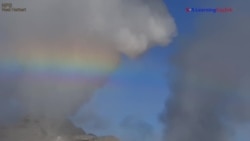This week, America celebrated the National Park Service’s 100th birthday.
Yellowstone National Park became America’s first national park in 1872. The National Park Service was formed 44 years later in 1916.
Yellowstone, which is mostly in the state of Wyoming, is considered an example of the success of the National Park System.
Humans have been present in Yellowstone for more than 11,000 years.
The first organized exploration of the area which lies close to the continental divide of North America took place in 1870.
Those first organized explorers must have seen right away how special the land was.
Yellowstone contains beautiful mountains, deep canyons, lakes and rivers.
The name Yellowstone comes from the river running through the area. At first known as Rock Yellow River, it became known as the Yellowstone River.
Yellowstone is host to many different species of plants. However, the park is most special because of what lies underneath it. It sits on top of an ancient super volcano, known as The Yellowstone Caldera. The caldera is 48 by 72 kilometers. And it remains an active volcano.
It is believed that the last time the volcano exploded or erupted was one half million years ago. The area has had three major eruptions in the last three million years.
Experts say it may erupt again in another 1,000 to 10,000 years. But each year, there are thousands of earthquakes at Yellowstone. Most are too small to be felt by people visiting the park.
Geothermal wonders mark Yellowstone
Yellowstone is filled with the beauty of many thermal or hot water springs. Of all the geothermal places in the world, half are in Yellowstone.
In places of geothermal activity, hot water and gasses are trapped under the earth’s crust. In places like Yellowstone, they rush to the surface in the form of hot water and steam to form geysers.
There are more geysers and hot springs in Yellowstone than anywhere else on Earth. The most famous geyser is Old Faithful. It erupts about every hour or hour and a half. The eruption can last from one and a half minutes up to 5 minutes. The amount of hot water it expels in that time can be as much as 31,000 liters or more.
Yellowstone shelters protected wildlife
In addition to its beauty and wonder, Yellowstone is an animal sanctuary. It is home to the largest group of wild animals in the lower 48 United States. As you travel through the park, you can sometimes see them in their natural habitat and hear their calls to mate and defend themselves. Listen to this elk’s bugle.
There is still a wild west in America and its name is Yellowstone.
I’m Dorothy Gundy.
Dorothy Gundy adapted this report, with materials from VOA Learning English archive and the National Parks Service. Mario Ritter was the editor.
_______________________________________________________________
Words in This Story
continental divide - n. the watershed of North America made of the line of highest points of land separating the waters flowing west from those flowing north or east matching with various ranges of the Rockies, extending from Canada to South America
sanctuary - n. a place where someone or something is protected or given shelter
habitat – n. the place or type of place where a plant or animal naturally or normally lives or grows
bugle – n. the call of the bull elk
Have you visited Yellowstone National Park? We want to hear from you. Write to us in the Comments Section.











